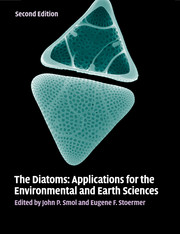Book contents
- Frontmatter
- Contents
- List of contributors
- Preface
- Part I Introduction
- Part II Diatoms as indicators of environmental change in flowing waters and lakes
- Part III Diatoms as indicators in Arctic, Antarctic, and alpine lacustrine environments
- Part IV Diatoms as indicators in marine and estuarine environments
- Part V Other applications
- 24 Diatoms of aerial habitats
- 25 Diatoms as indicators of environmental change in wetlands and peatlands
- 26 Tracking fish, seabirds, and wildlife population dynamics with diatoms and other limnological indicators
- 27 Diatoms and archeology
- 28 Diatoms in oil and gas exploration
- 29 Forensic science and diatoms
- 30 Toxic marine diatoms
- 31 Diatoms as markers of atmospheric transport
- 32 Diatoms as non-native species
- 33 Diatomite
- 34 Stable isotopes from diatom silica
- 35 Diatoms and nanotechnology: early history and imagined future as seen through patents
- Part VI Conclusions
- Glossary, acronyms, and abbreviations
- Index
- References
31 - Diatoms as markers of atmospheric transport
from Part V - Other applications
Published online by Cambridge University Press: 05 June 2012
- Frontmatter
- Contents
- List of contributors
- Preface
- Part I Introduction
- Part II Diatoms as indicators of environmental change in flowing waters and lakes
- Part III Diatoms as indicators in Arctic, Antarctic, and alpine lacustrine environments
- Part IV Diatoms as indicators in marine and estuarine environments
- Part V Other applications
- 24 Diatoms of aerial habitats
- 25 Diatoms as indicators of environmental change in wetlands and peatlands
- 26 Tracking fish, seabirds, and wildlife population dynamics with diatoms and other limnological indicators
- 27 Diatoms and archeology
- 28 Diatoms in oil and gas exploration
- 29 Forensic science and diatoms
- 30 Toxic marine diatoms
- 31 Diatoms as markers of atmospheric transport
- 32 Diatoms as non-native species
- 33 Diatomite
- 34 Stable isotopes from diatom silica
- 35 Diatoms and nanotechnology: early history and imagined future as seen through patents
- Part VI Conclusions
- Glossary, acronyms, and abbreviations
- Index
- References
Summary
Introduction
“The dustiest place on earth” is the Bodélé depression in Chad which contains an extensive diatomite formed by the paleolake MegaChad (Giles, 2005). It is the source of an estimated 61,000 cubic kilometres of diatoms transported by wind from the area during the past thousand years (Bristow et al., 2008). Satellite imaging of dust plumes reveals it to be the largest source of global airborne dust today (Goudie, 2008). Most natural eolian dust comes from drainage depressions in deserts (Middleton and Goudie, 2001). Many of these once held large water bodies such as MegaChad, West Africa; Owens Lake, North America; Lake Eyre, Australia; and the Aral Sea, Eurasia (Warren et al., 2007).
Scientists trap eolian material for various objectives: atmospheric scientists interested in particles and aerosols, aerobiologists in disease spores and allergens, biologists in dispersal, and forensic workers interested in airborne contaminants (diatoms: Geissler and Gerloff, 1966). Collection techniques involve either passive or active traps; the first exposes funnels or adhesive surfaces and the second pumps air through filters (Lacey and West, 2006). Diatom remains are rare in most traps, and, when present, are not always recognized.
Sometimes living diatoms are aerially dispersed. They rarely grow on exposed agar plates or culture media (Kristiansen, 1996; Broady, 1996); few airborne diatoms are intact (Elster et al., 2007); and motile diatoms normally avoid drying surfaces (Marshall and Chalmers, 1997).
- Type
- Chapter
- Information
- The DiatomsApplications for the Environmental and Earth Sciences, pp. 552 - 559Publisher: Cambridge University PressPrint publication year: 2010
References
- 9
- Cited by



